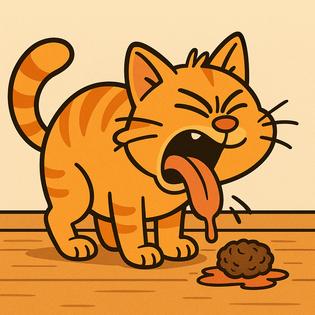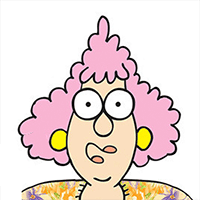Cats and hairballs are simply a fact of life... if you're a cat
Published in Cats & Dogs News
Cats are often praised for their elegance and independence, but pet owners know they come with a few less glamorous realities. One of the most common and messy of these is the hairball. While the sight and sound of a cat hacking up a hairball may be unpleasant, the issue is natural and usually harmless. Still, understanding what hairballs are, why they occur, and how to manage them can make life easier for both felines and their human companions.
Hairballs, also known by the scientific term trichobezoars, form when cats ingest loose fur during grooming. Because a cat’s tongue is covered in tiny, backward-facing barbs called papillae, it naturally collects loose hairs. While much of this fur passes harmlessly through the digestive system and is excreted in stool, some accumulates in the stomach. When the fur clumps together rather than moving through the intestines, it forms a hairball. Cats eventually expel these by vomiting, often with dramatic sound effects and a considerable amount of mess.
Most cats will experience hairballs at some point in their lives. Long-haired breeds like Persians and Maine Coons are particularly prone due to the sheer volume of hair they shed and ingest. However, even short-haired cats can suffer from them, especially during shedding seasons in spring and fall or if they overgroom due to stress, skin irritations or underlying health problems. Kittens and younger cats are less likely to produce hairballs simply because they have not yet perfected the meticulous grooming habits of adults.
While an occasional hairball is usually nothing to worry about, frequent occurrences may indicate a problem. If a cat vomits hairballs more than once or twice a month, it could be a sign of excessive grooming, a skin allergy, or a gastrointestinal issue. In rare cases, hairballs can cause life-threatening blockages if the mass of fur becomes lodged in the intestines. Symptoms of such a blockage include persistent vomiting, constipation, lethargy, and a swollen abdomen. Veterinary attention is critical if any of these signs appear.
For most cats, however, hairballs are simply a nuisance. Pet owners looking to reduce their cat’s hairball episodes have several effective strategies to consider. The most straightforward is regular grooming. Brushing a cat daily, or at least several times a week, can significantly cut down on the amount of loose hair available for ingestion. Slicker brushes and deshedding tools like the Furminator are especially helpful for long-haired breeds. Many cats enjoy being brushed, though others may need some gentle acclimation to the process.
Another useful tactic is dietary adjustment. Some cat foods are specially formulated to help minimize hairballs. These products often contain higher fiber content to assist in moving ingested fur through the digestive tract. A veterinarian can recommend a suitable option, and it may take a few weeks to notice a difference. Adding a bit of plain canned pumpkin to a cat’s diet, a half teaspoon every few days, is another vet-approved method that provides gentle fiber and can aid digestion.
There are also a number of over-the-counter hairball remedies available. These typically come in gel or paste form and act as mild laxatives or lubricants to help fur pass through the digestive system more smoothly. Most are flavored to be palatable to cats and can be offered directly or added to food. While safe for most felines, they should be used according to instructions and not as a replacement for veterinary advice in more serious cases.
Encouraging hydration is another key aspect of managing hairballs. Cats often do not drink enough water, especially if they eat primarily dry kibble. Providing fresh water daily, using a cat water fountain, or supplementing with wet food can improve overall digestion and help move hair through the gastrointestinal tract. A hydrated cat is less likely to experience digestive slowdowns that allow hairballs to form.
In some cases, modifying behavior may help. If a cat is grooming excessively due to anxiety, boredom or skin discomfort, addressing the root cause can reduce hairball frequency. Providing enrichment such as toys, climbing spaces, and interactive playtime can alleviate boredom. Flea treatments or changes in diet may soothe irritated skin. In cases of compulsive grooming, a veterinarian or veterinary behaviorist can help identify and address the underlying issue.
While hairballs may never disappear entirely from a cat owner’s life, understanding them and taking proactive steps can make a noticeable difference. Regular grooming, dietary fiber, hydration, and monitoring of behavior all play a role in reducing their occurrence. Most importantly, keeping a watchful eye on frequency and severity ensures that an annoying but normal part of cat ownership does not develop into a more serious health concern.
It is also important for cat owners to know the difference between a typical hairball event and other forms of vomiting. When a cat hacks up a hairball, it usually involves retching and eventually the expulsion of a wet, cylindrical clump of fur. This is distinct from vomiting food or bile, which may suggest other gastrointestinal issues. Chronic vomiting of any kind should not be written off as hairballs and deserves a vet’s input.
Hairballs can also become more frequent with age. As cats grow older, their digestive systems may become less efficient, and their grooming habits can increase due to boredom or physical discomfort. Senior cats in particular benefit from a combination of grooming support and veterinary monitoring. Regular check-ups can identify early signs of any digestive changes or illnesses that might be contributing to the problem.
Another potential concern with frequent hairball production is that it might mask or exacerbate other health issues. A cat suffering from inflammatory bowel disease, for instance, may exhibit symptoms that mimic those of hairball problems. Similarly, a cat with undiagnosed diabetes or kidney disease may groom excessively due to discomfort or neurological changes. It is therefore vital to consider the whole picture rather than assuming that vomiting or hacking is always caused by hairballs.
In multi-cat households, owners should also be aware of which cat is producing the hairballs. If one cat is vomiting regularly but the mess is discovered after the fact, it can be challenging to determine the source. Observing litter box habits, appetite changes, or grooming behavior can offer clues, but in persistent cases, it may be worthwhile to isolate cats temporarily or install cameras to monitor behavior and health.
Even though they’re unpleasant, hairballs are often just a part of living with a cat. They’re a reminder of the incredible grooming behavior cats possess and the minor trade-offs involved in cohabiting with a fastidiously clean animal. While not dangerous most of the time, they do require attention and management. Cat owners who stay informed, observant and proactive are more likely to keep their feline companions healthy and comfortable—and reduce the number of early morning surprises left on the carpet.









Comments